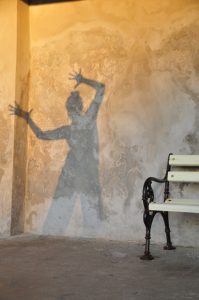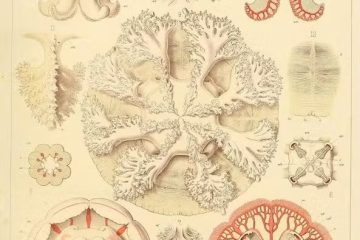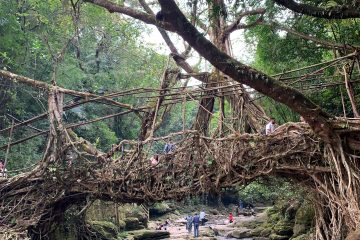Body Knowledges and Practices (and the Coronavirus)

Coming down with the coronavirus reminded me once again of how important it is to take seriously the role of bodies in processes of meaning-making. My creativity was as low as my fever was high, and my body quite literally told me: Our bodily state defines the possibilities of our interaction with our environment. I can only gather from other accounts about how the infection can impact our social and cultural being, which is intrinsically linked to functioning in a system of actions and semantics. People experience enhanced fatigue, brain fog, and loss of words—the virus thus disables usual ways of communication. And this is only the most obvious level.
Scientists found that an infection can significantly diminish the gray matter of our brain, responsible for memory. Can this change our experience of incoming sensation? Can this change our emotional response to things, if emotions and experiences are understood as conceptualizations and realizations of our cumulative bodily interactions? Can this change our way of meaning-making? I currently observe a lingering impact of the infection on my cognitive abilities. I feel as if a wall has been built up between me and the rest of the world, and as an online test confirms, my processing speed and coordination skills are much below average.
About five to ten years ago I went through a phase in my life when I needed to redefine my identity (to reinvent myself, if you will), and I also needed to find a way of coping with challenges in the social and cultural net in which I was embedded. That was when I came across dance, and soon I could not live without dancing. I became curious about what dancing did to me; how was it that dancing could gain such a centrality in my life? I knew partaking in dance classes did something to my body; it triggered some body knowledge, which changed the way I participated in society and culture. I learned more about this mechanism by studying others: It turned out that the dance classes I participated in where part of what can be called ‘neo-spiritual’ practices. We can describe these practices by their aesthetics and the embodied transformation they evoke through special techniques—e.g., they train and therefore habitualize a bodily state of awareness with regard to sensations; they create a bodily state experienced as state of transcendence; they evoke an emotional-habitual state of happiness connected to the physical exhaustion at the end of practicing; and they change the physical appearance of your body.
I found that all these embodied transformations—among others—not only cause extraordinary and positive experiences, which lead to an addictive effect of wanting and longing for more, but also change how the practitioners behave outside the direct context of dancing. They change how we experience ourselves and the world in general. They change bodies as they interface with the world, and they change how bodies interpret and act in the world. These practices alter bodies and subsequently the processes of meaning-making that are bodily processes themselves. The practices are even characterizable and categorizable by their particular modes and techniques of changing bodies (such as neo-spiritual practices). In turn, this observation underlines what many others, such as Maurice Merleau-Ponty, Marcel Mauss, Pierre Bourdieu, Thomas Csordas, and Judith Butler, have long argued and highlighted: Meaning-making is bound to bodies, and to bodies shaped in practices. Collective practices shape collective bodies; they generate habitus and implement shared worldviews.
This is, of course, overly simplified. There are many entangled layers of practicing. Practices affect socialized bodies—bodies emerging and situated in a social and cultural environment, bodies already affected by practicing. Further, they don’t affect socialized bodies isolated from each other but through socialized spaces, which are already physical and influence processes of meaning-making on their own terms. Moreover, practices affect bodies through many forms of relational aesthetics, ranging from physical movement to auditive stimulation. Thus, practices and bodies might best be understood as aesthetic assemblages—as assemblages which implicitly and explicitly, semantically and non-semantically, materially and immaterially, affect bodies and subsequently influence processes of meaning-making.
In this light, we could describe the coronavirus as a practice and aesthetic assemblage. Mandatory measures like wearing a mask define the amount of viral load I am exposed to. The virus’ DNA itself is the result of global traveling, as it did not start out with the variant I was exposed to. But this is the interesting point: My affected body forms part of the assemblage. What is more, my body is itself an assemblage, a product of being submitted to prior practices and affects, which now determines its possibilities to react to the virus. Did I have access to vaccines? Did I have access to sufficient healthcare and nutrition or even stress- and work-free phases, which determined the bodily state in which the virus infected me? Do I have access to treatments? But also: What are my genetic preconditions? Long covid does seem to have a preference for people with two X chromosomes. And so on.
The deeper you dig, the more complex it seems to get. Bodies are relational social products. The virus is not simply affecting my body; rather, it is a complex aesthetic assemblage that affects other complex assemblages, which define its capacities to be affected. My affected body remains as and embedded in an assemblage beyond individual control, assemblages of which I cannot claim to be sovereign over. Therefore, ultimately, both kinds of assemblages—the coronavirus assemblage and our bodily assemblages—tell stories of recent and older power structures, which we should listen to very carefully before making firm decisions about how to address the pandemic.
Taking bodies and bodily practices seriously implies that we see social and cultural phenomena as practices that affect bodies. But we also need to critically rethink our understanding of the “nature of bodies” and the category “body” itself, which brings us closer to a non-positivistic understanding that sees bodies as relational. Yes, we cannot be without our bodies—we are our bodies. But we are not and will never be solely responsible for the bodies we are. By extension, we must care for our environment because we are our environment. Put differently, we are responsible for our environments because our environments cannot escape our actions.
#
Lina Aschenbrenner, PhD, is a postdoctoral fellow in the religious studies department at the University of Erfurt (Germany). Her interests lie with contemporary religion, aesthetics, embodiment, and power structures. In her PhD project she focused on the aesthetics of the Israeli movement practice “Gaga” as an example of embodied neo-spirituality. Outside academia, she teaches and creates dance with and for children and adolescents.
Counterpoint blogs may be reprinted with the following acknowledgement: “This article was published by Counterpoint Navigating Knowledge on 23 March 2022.”
The views and opinions expressed on this website, in its publications, and in comments made in response to the site and publications are those of the author(s) and do not necessarily reflect the views and opinions of Counterpoint: Navigating Knowledge, its founders, its staff, or any agent or institution affiliated with it, nor those of the institution(s) with which the author is affiliated. Counterpoint exists to promote vigorous debate within and across knowledge systems and therefore publishes a wide variety of views and opinions in the interests of open conversation and dialogue.
Photo credit: © Marianne Aschenbrenner, 2019, printed with permission



